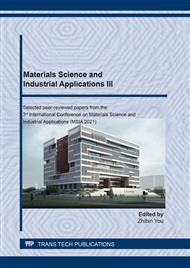[1]
Y.B. Xiao, Y.Z. Xu, K.Y. Zhang, et al, Coaxial electrospun free-standing and mechanically stable hierarchical porous carbon nanofiber membranes for flexible supercapacitors, Carbon. 160 (2020) 80-87.
DOI: 10.1016/j.carbon.2020.01.017
Google Scholar
[2]
K. Navaporn, C. Surawut, H. Kan, et al, Influence of the viscosity ratio of polyacrylonitrile/poly (methyl methacrylate) solutions on core-shell fibers prepared by coaxial electrospinning, Polym. J. 49 (2017) 497-502.
DOI: 10.1038/pj.2017.8
Google Scholar
[3]
Y. Lu, J.N. Huang, G.Q. Yu, et al, Coaxial electrospun fibers: applications in drug delivery and tissue engineering, Wires Nanomed. Nanobiotechnol. 8 (2016) 654-677.
DOI: 10.1002/wnan.1391
Google Scholar
[4]
H.A. Alam, A.D. Dalgic, A. Tezcaner, et al, A comparative study of monoaxial and coaxial PCL/gelatin/Poloxamer 188 scaffolds for bone tissue engineering, Int. J. Polym. Mater. Po. 69 (2020) 339-350.
DOI: 10.1080/00914037.2019.1581198
Google Scholar
[5]
Z. Qin, P. Zhang, Z. Wu, et al, Coaxial electrospinning for flexible uniform white-light-emitting porous fibrous membrane, Mater. Design. 147 (2018) 175-181.
DOI: 10.1016/j.matdes.2018.03.040
Google Scholar
[6]
B.Y. Huang, Y.R. Wang, Q. Hu, et al, A low temperature and highly sensitive ethanol sensor based on Au modified In2O3 nanofibers by coaxial electrospinning, J. Mater. Chem. C. 6 (2018) 10935-10943.
DOI: 10.1039/c8tc03669a
Google Scholar
[7]
L. Del Bianco, F. Spizzo, P. Sgarbossa, et al, Dipolar magnetic interactions in Mn-doped magnetite nanoparticles loaded into PLGA nanocapsules for nanomedicine applications, J. Phys. Chem. C. 123 (2019) 30007-30020.
DOI: 10.1021/acs.jpcc.9b09146
Google Scholar
[8]
S. Kim, H. Sah, Merits of sponge-like PLGA microspheres as long-acting injectables of hydrophobic drug, J. Biomater. Sci. Polym. Ed. 30 (2019) 1725-1743.
DOI: 10.1080/09205063.2019.1659712
Google Scholar
[9]
X. ZONG, K. KIM, D. FANG, et al, Structure and process relationship of electrospun bioabsorbable nanofiber membranes, Polymer. 43 (2002) 4403-4412.
DOI: 10.1016/s0032-3861(02)00275-6
Google Scholar
[10]
A. Celebioglu, T. Uyar, Electrospun porous cellulose acetate fibers from volatile solvent mixture, Mater. Lett. 65 (2011) 2291-2294.
DOI: 10.1016/j.matlet.2011.04.039
Google Scholar
[11]
G.J. Jiang, S. Zhang, X.H. Qin, Effect of processing parameters on free surface electrospinning from a stepped pyramid stage, J. Ind. Text. 45 (2014) 483-494.
DOI: 10.1177/1528083714537101
Google Scholar


